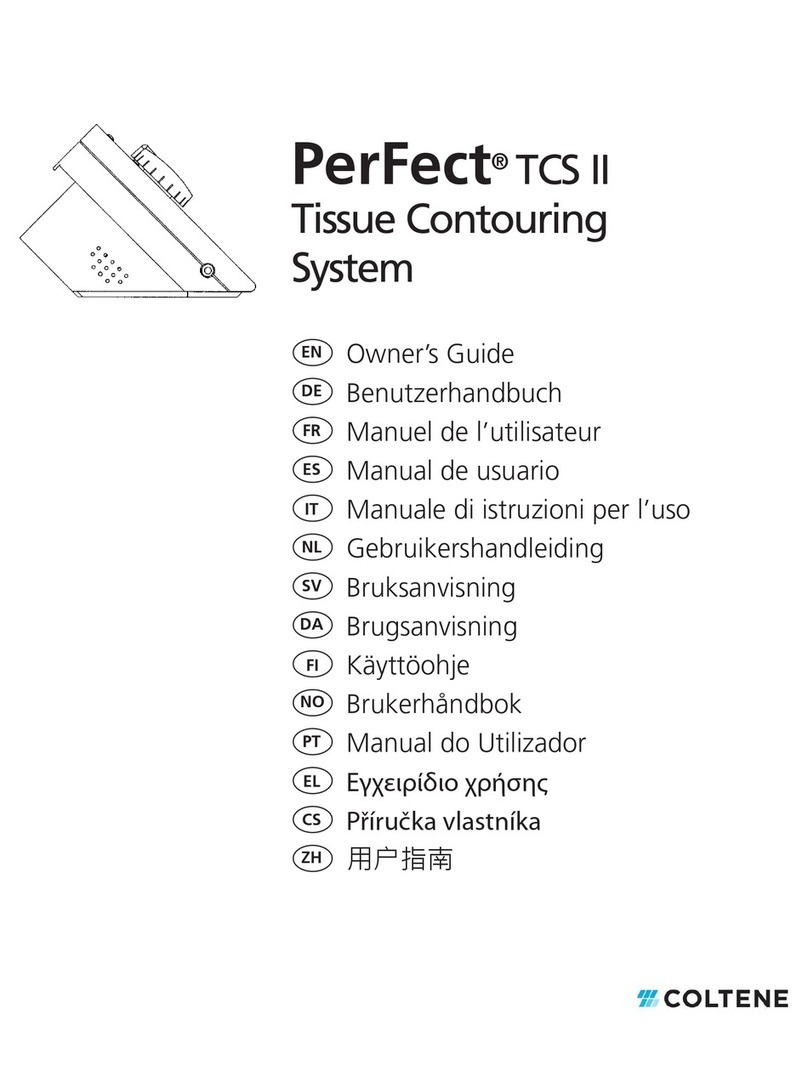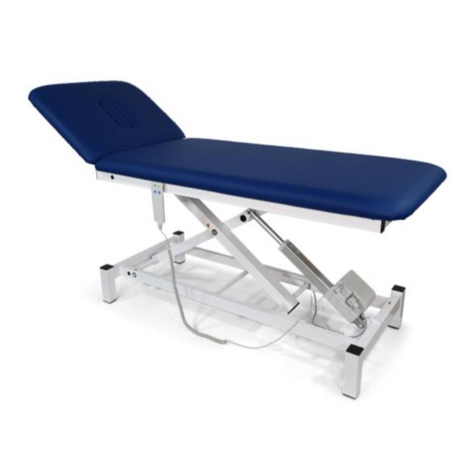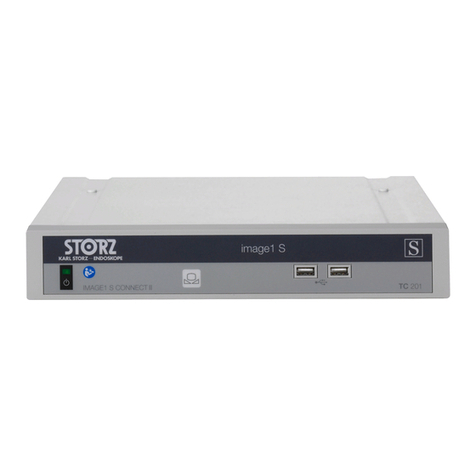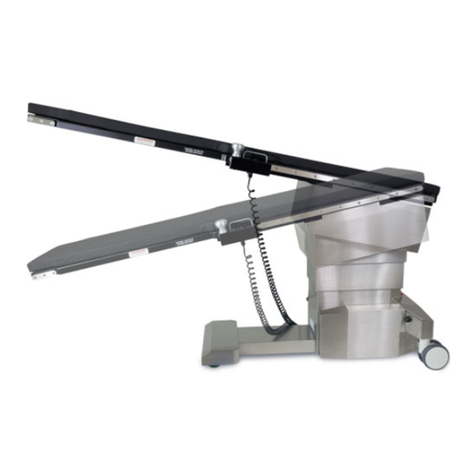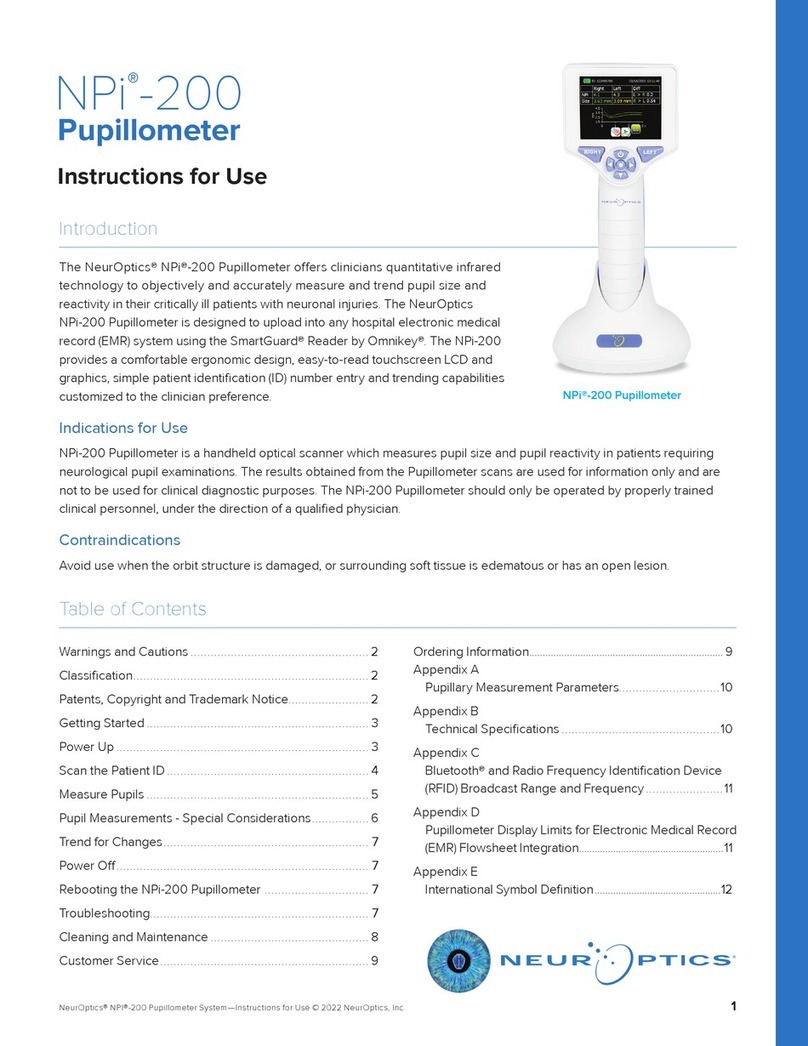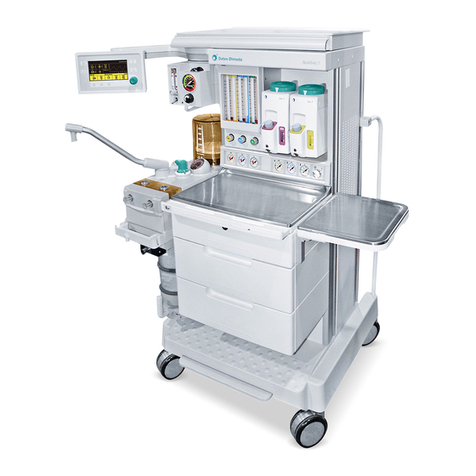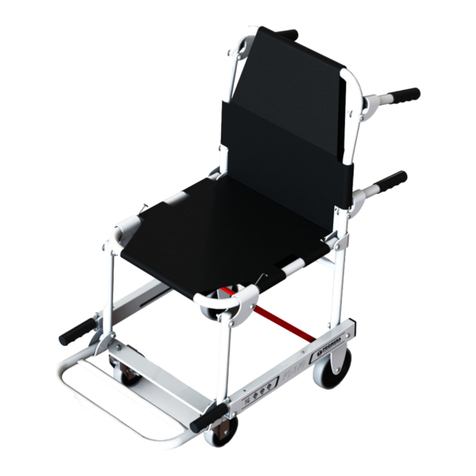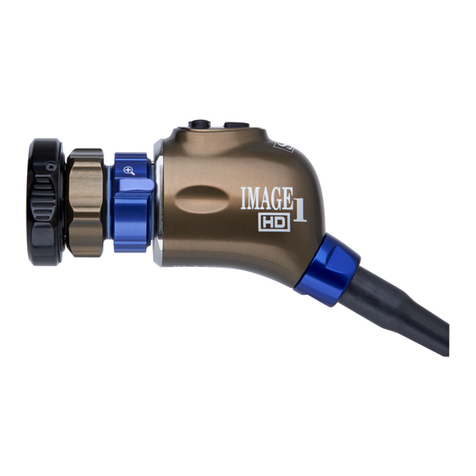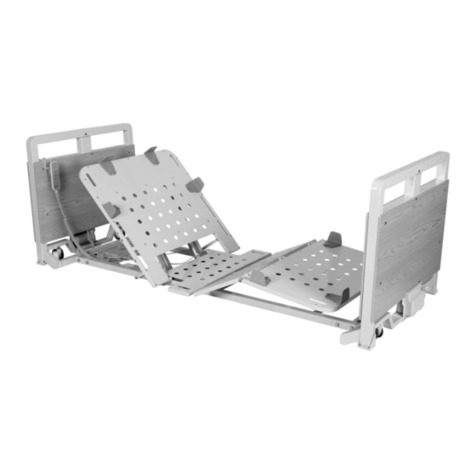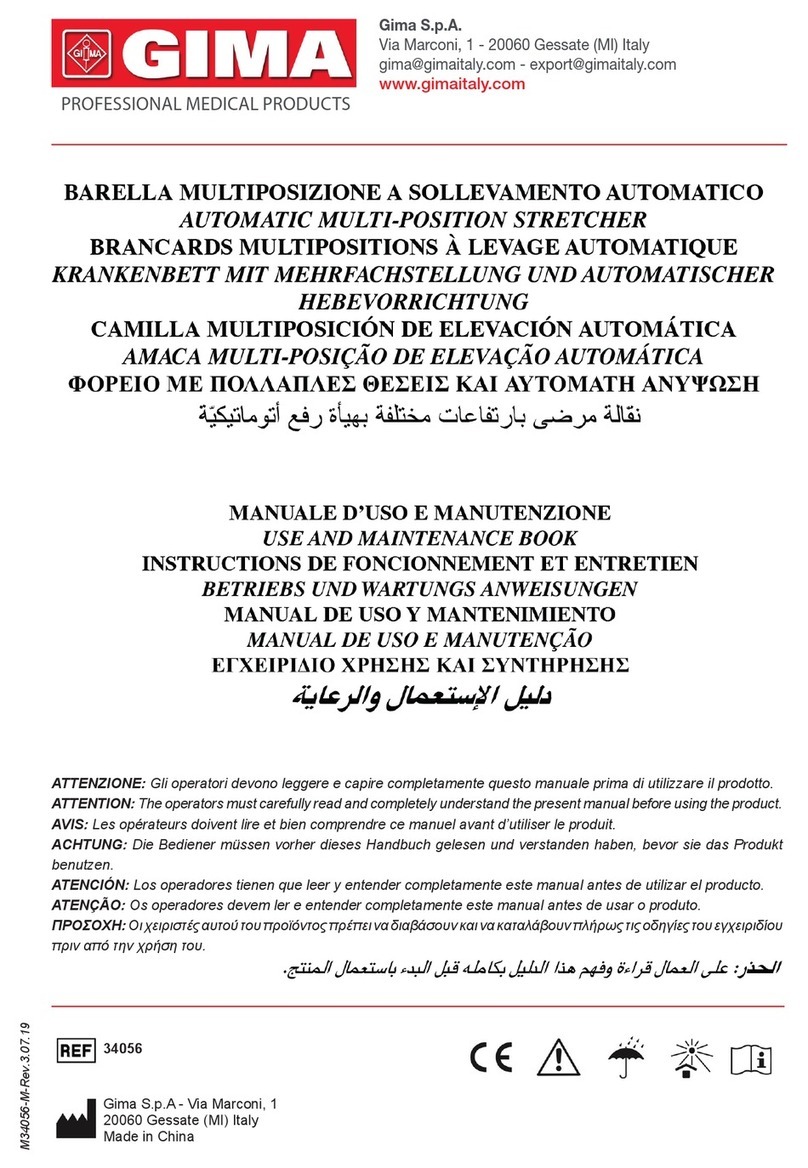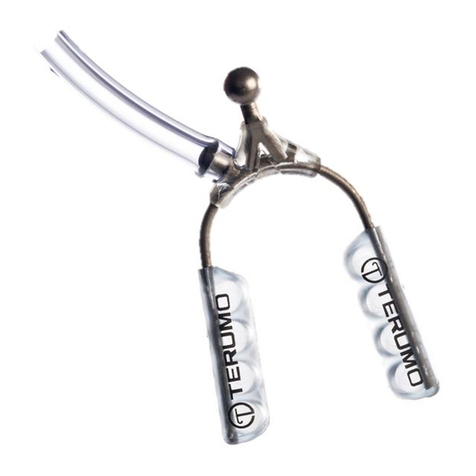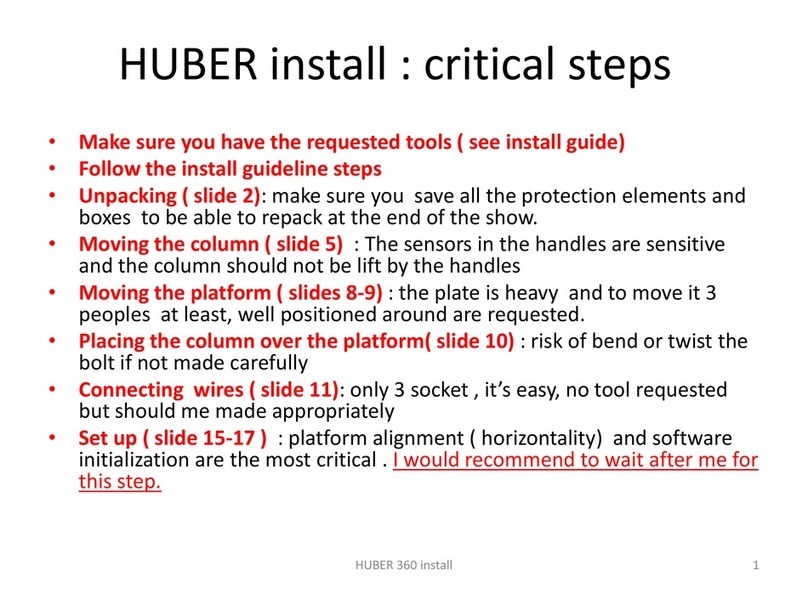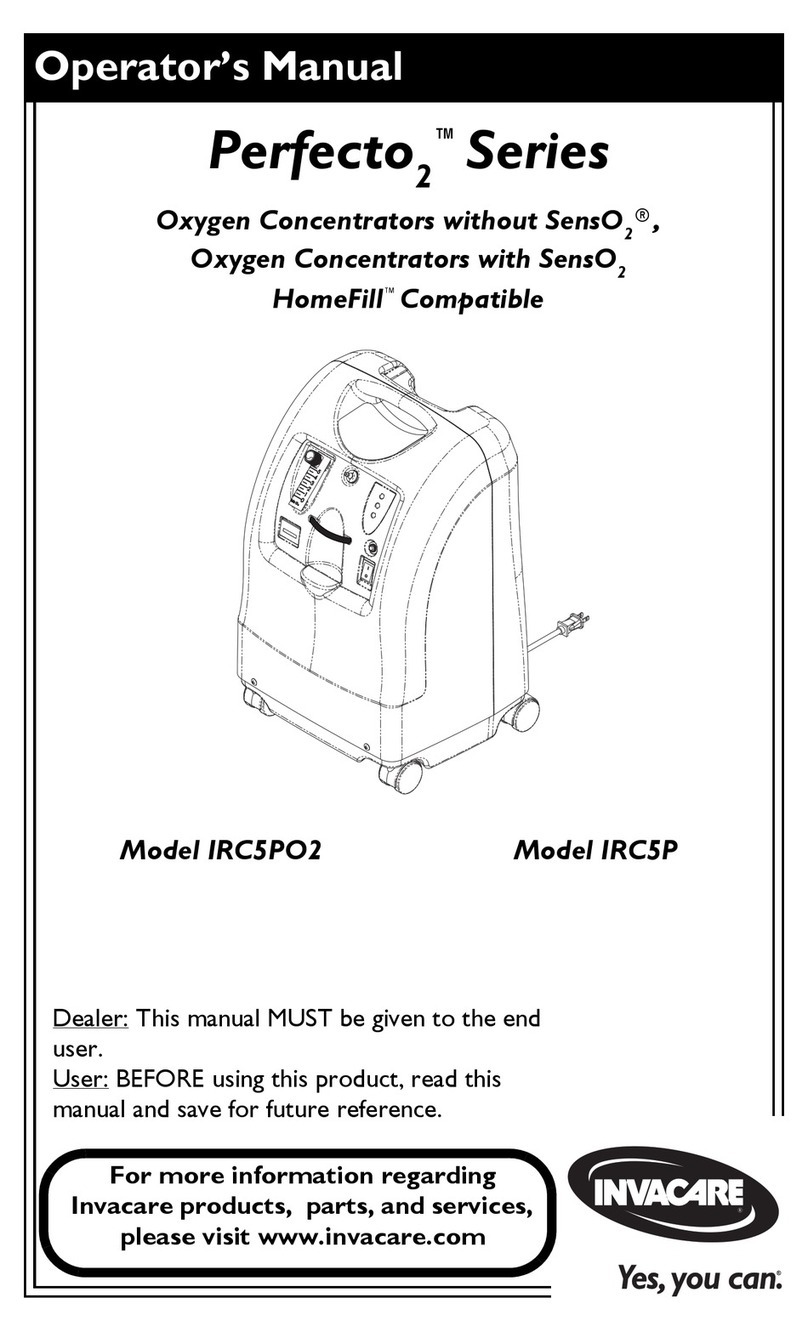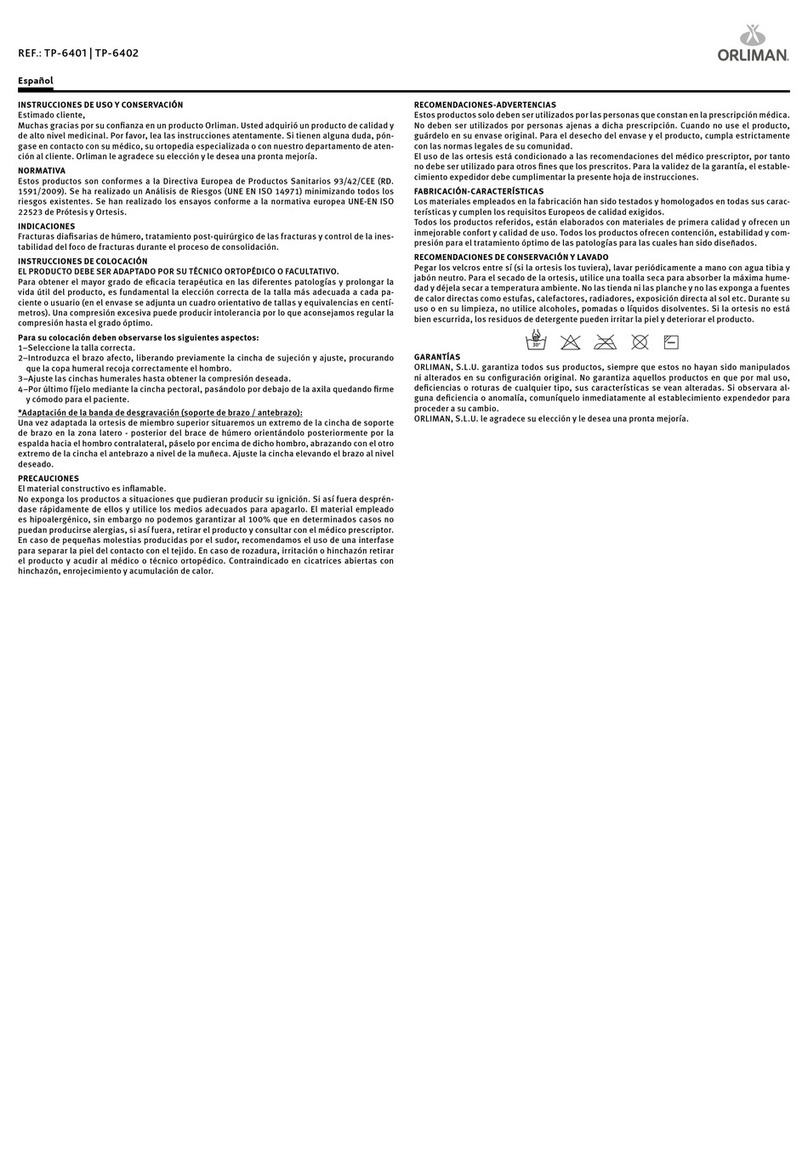medlab EG01010 User manual

Medlab medizinische Diagnosegeräte GmbH EG01010 User Manual
Version 1.06
1 1
Three Lead
ECG OEM board
EG01010
Technical Manual
Copyright © Medlab 2008 - 2022
Version 1.06
medlab

Medlab medizinische Diagnosegeräte GmbH EG01010 User Manual
Version 1.06 2
2
Medlab medizinische Diagnosegeraete GmbH
Helmholtzstrasse 1a
76297 Stutensee
Germany
Tel. +49(0)7244 741100
www.medlab.eu

2
Medlab medizinische Diagnosegeräte GmbH EG01010 User Manual
Version 1.06
2 3
Table of Contents
Mechanical Dimensions of the Module 4
Overview 5
Description of the Module and Connectors 6
Physical Units of Transmitted Data 6
Technical Data (Specifications) 7
Connectors 8
Header for host connection 8
Header for patient cable connection 8
Technical Description for TRF EN 60601-2-27 9
Software Protocol Description 11
Serial Transmission Protocol 1 12
Test Program for Protocol 1 15
Serial Transmission Protocol 2 16
Test Program for Protocol 2 23
Regulatory Considerations 24

Medlab medizinische Diagnosegeräte GmbH EG01010 User Manual
Version 1.06 4
4
Mechanical Dimensions of the Module
Mechanical drawing, top view of the module (1:1)
All
Dimensions
in mm
13.5
9.5
2.54
2.2
23
47
53
72
88
1.6
5.08

4
Medlab medizinische Diagnosegeräte GmbH EG01010 User Manual
Version 1.06
4 5
Overview
The scope of this document is the description and specification of Medlab's three lead ECG board
EG01010. It should help anybody who is familiar with both programming and basic electronics to select
the proper hardware and software version for his application as well as to help him integrate the board
into his own electronic system.
The EG01010 measures one of three channels of ECG using a three lead cable. Through the use of the
second transmission protocol and an additional respiration board it is also possible to measure the respi-
ration rate.
The ECG board has two connectors, as seen on the drawing on next page. The ECG module is
connected to the host system via the host and power connector. It provides the power supply for the
board and the communication with the host system. The EG01010 has full patient isolation on board, that
means that the input voltage of 5V has no galvanic contact to patient. The isolation gap can be easily
seen on the board and this area is only bridged by a transformer and the opto couplers. The patient cable
is connected to the ECG module by the patient cable connector. The ECG-board is defibrilation protected.
It is important that the board is directly connected to the ECG-cable connector and cable. This is to ensu-
re the patient isolation and the correct measurements of the board.
With a three lead cable, the module can output the following channels: I or II or III. Only one curve at a
time can be measured, e.g. Einthoven I or II or III. By using an optional respiration board in conjunction
with the second transmission protocol it is also possible to measure the respiration rate of the patient.
This is achieved by measuring the impedance change between the electrodes.
The isolated ground of the module is switched to the unused electrode in the respective setting, e.g. isola-
ted ground is on the left leg electrode if the module is set to channel I, left hand electrode if module is set
to channel II and right hand electrode if channel III is selected.
There are two transmission protocols for communication with the main unit available. The used protocol
is depending on the installed software version. The baud rate used for the data transmission is also
depending on the used protocol.

Medlab medizinische Diagnosegeräte GmbH EG01010 User Manual
Version 1.06 6
6
Physical Units of Transmitted Data
Scaling of ECGs is normally done in the unit "cm/mV" for the Y-axis and in "mm/sec" for the X-axis.
The respiration rate is transmitted in „rpm“ (respirations per minute).
The pulse rate is transmitted in „bpm“ (beats per minute).
The transmission speed for the wave is indicated in Hz (sec-1).
The ECG amplitudes are normally indicated in „cm/mV“. Since this is depending directly on the resolution
of the screen the user is working with, the transmitted samples are not directly scaled in this unit, but fall
into the range of 0-0xF7 (8 Bit samples, 0xF8 to 0xFF reserved for commands). It is within the responsi-
bility of the user to scale the transmitted samples in a way that the waves displayed onto his screen fit to
the usual scales used in medicine, 0.5, 1, 2 and 4 cm/mV. The amplification of the module in the different
amplification stages is:
Stage 1 Stage 2 Stage 3
1mv = 32 1mV = 64 1mV = 128
Normal values for the trace speed are 12.5 mm/sec, 25 mm/sec and 50 mm/sec.
Connector Respiration Board
Connector Respiration Board
Patient Isolation
Host & Power
Connector
Patient Cable
Connector
Mounting Holes
Description of connectors and areas of the module (1:1)
Description of the Module and Connectors

6
Medlab medizinische Diagnosegeräte GmbH EG01010 User Manual
Version 1.06
6 7
Technical Data (Specifications)
Mechanical data: 88 mm x 53 mm
see page 4 for board drawing
4 layer PCB, thickness 1.5 mm
Maximum height: 12 mm
With respiration option: 25 mm
Attachment: four M2.5 screws in the corners of the PCB
Weight: 32 g
Operating voltage: 5 Volt, ± 10 %, 45 mA
Power consumption: 225 mW while measuring
Input: Defibrillation protected
Patient Isolation: CF, 4000 Volts RMS
Amplification: Three levels, user selectable
Data transmission: Three frequencies, user selectable
Filtering: Integrated 50 Hz or 60 Hz notch filter
Amplifier frequency range: 0.05 to 70 Hz
Pulse detection: 30 .. 247 bpm ± 1%, ± 1 Digit, 8 beat average
Respiration detection: 5 .. 99 rpm ±3%, ± 1 Digit, 8 samples average (option)
Output: Asynchronous serial output with CMOS levels (0 ... 5 V)
Hardware pulse trigger output, CMOS levels (0 ... 5 V)
Both outputs fully isolated from patient
Protocol: Standard bidirectional serial protocol, see description
on following pages
Connector: Connectors compatible to Medlab EG05000 five channel OEM board
Optional connectors for Medlab 00731 respiration board

Medlab medizinische Diagnosegeräte GmbH EG01010 User Manual
Version 1.06 8
8
Header for patient cable connection
SV1: 1 Unused
2 SHIELD
3 LL-IN
4 RA-IN
5 LA-IN
6 SHIELD
7 Unused
Connectors
(see attached drawing for location)
Header for host connection
JP1: 1 Ground
2 Ground
3 Txd (RS232 level +/- 5Volt)
4 Txd (TTL level)
5 Rxd (RS232 level +/- 5Volt)
6 Rxd (TTL level)
7 Not connected
8 Not connected
9 Not connected
10 Not connected
11 Pulse Trigger output
12 Pulse Trigger output
13 Shutdown (VCC level on this pin powers down module)
14 Shutdown (VCC level on this pin powers down module)
15 VCC input
16 VCC input
Note: The pulse trigger is a high active, rectangular signal with a pulse width of 33 ms. Delay to the R wave can be
adjusted by a command.
Five
Lead Patient Cable
Four
Lead Patient Cable
Three
Lead Patient Cable
I and II and III
and aVL and aVR and aVF and C
I and II and III
and aVL and aVR and aVF
I or II or III
Shield
Shield
Shield
Shield
Left Arm
Left Leg
Right Arm
Right Arm
Left Leg
Left Arm
Right Leg
Chest
Shield
Shield
Right Arm
Left Leg
Left Arm
Right Leg
ECG cable connection
Remark:
For respiration measurement (optional respiration board needed), electrodes should
be attached to chest and hip, not arm and leg.
Please note that the leg clamp has to be connected to
the left leg or hip. If you connect this clamp to the right
leg or hip the signal quality decreases heavily.

8
Medlab medizinische Diagnosegeräte GmbH EG01010 User Manual
Version 1.06
8 9
Technical Description for TRF EN 60601-2-27
When preparing a test report form (TRF) for proof of compliance of the user's medical product to EN
60601-2-27, the following remarks / technical data will be helpful or needed:
Input Impedance: > 10 MOhm
Common mode rejection ratio: > 90 dB at 50 Hz or 60 Hz
Input Dynamic Range: ±5 mV AC, ±300 mV DC
Defibrillator Discharge Recovery: <10 sec per IEC 601-2-27
<10 sec per AAMI EC13-1992
Leads-off sensing current: Applied currents less than 150 nA
The following information references particular sections of EN 601-2-27
Respiration (optional), section 201.7.9.2.9.101 b) 1)
Applied currents less than 80 µA @ 80 kHz square
Tall T-wave rejection, section 201.9.2.9.101 b) 2)
T-wave of 1.1 mV amplitude will not affect heart rate determination.
Heart rate averaging, section 201.7.9.2.9.101 b) 3)
TBD
Response to irregular rhythm, section 201.7.9.2.9.101 b) 4)
A1) Ventricular bigeminy: the EG01010 counts both large and small QRS complexes to display a rate of
80 bpm.
A2) Slow alternating ventricular bigeminy: the EG01010 counts both large and small QRS complexes to
display a rate of 60 bpm.
A3) Rapid alternating ventricular bigeminy: the EG01010 counts all QRS complexes to display a rate of
120 bpm.
A4) Bi-directional systoles: the EG01010 counts all QRS complexes to display a rate of 90 bpm.
Heart rate meter response time, section 201.7.9.2.9.101 b) 5)
a) Change from 80 to 120 BPM: 4 sec
b) Change from 80 to 40 BPM: 7 sec
Time to alarm for tachycardia, section 201.7.9.2.9.101 b) 6)
Waveform B1: Amplitude Time to alarm
0,5 mV 1 sec
1 mV 1 sec
2 mV 1 sec
Waveform B2 Amplitude Time to alarm
1 mV 1 sec
2 mV 1 sec
4 mV 1 sec
Pacemaker pulse display capability, section 201.12.1.101.12
The EG01010 is capable of displaying the ECG signal in the presence of
pacemaker pulses with amplitudes of ± 2 mV to ± 700 mV and durations of
0.1 ms to 2.0 ms. An indication for the pacemaker pulse is provided.

Medlab medizinische Diagnosegeräte GmbH EG01010 User Manual
Version 1.06 10
10
Pacemaker pulse rejection, section 201.12.1.101.13
Without over/undershoot:
a) For single (ventricular-only) pacemaker pulses alone, with 0.1 and 2.0 ms pulse-widths and ± 2 mV
and ± 700 mV pulse-amplitudes, the EG01010 correctly displays heart rate as zero bpm (Asystole).
b) For single (ventricular-only) pacemaker pulses with normally paced QRS-T, with 0.1 and 2.0 ms pulse-
widths and ± 2 mV and ± 700 mV pulse-amplitudes, the EG01010 correctly displays heart rate of the
QRS-T rhythm (60 bpm for the specified test waveform).
c) For single (ventricular-only) pacemaker pulses with ineffectively paced QRS pattern, with 0.1 and 2.0
ms pulse-widths and ± 2 mV and ± 700 mV pulse-amplitudes, the EG01010 correctly displays heart rate
of the underlying QRS-T rhythm (30 bpm).
d) For atrial/ventricular pacemaker pulses alone, with 0.1 and 2.0 ms pulse-widths and ± 2 mV and
± 700 mV pulse-amplitudes, the EG01010 correctly displays heart rate of zero bpm (Asystole).
e) For atrial/ventricular pacemaker pulses with normally paced QRS-T, with 0.1 and 2.0 ms pulse-widths
and ± 2 mV and ± 700 mV pulse-amplitudes, the EG01010 correctly displays heart rate of the QRS-T
rhythm (60 bpm).
f) For atrial/ventricular pacemaker pulses with ineffectively paced QRS pattern, with 0.1 and 2.0 ms pulse-
widths and ± 2 mV and ± 700 mV pulse-amplitudes, the EG01010 correctly displays heart rate of the
underlying QRS-T rhythm (30 bpm).
With over/undershoot:
a) For single (ventricular-only) pacemaker pulses alone, with 0.1 and 2.0 ms pulse-widths and ± 2 mV
and ± 700 mV pulse-amplitudes, the EG01010 correctly displays heart rate of zero bpm (Asystole).
b) For single (ventricular-only) pacemaker pulses with normally paced QRS-T, with 0.1 and 2.0 ms pulse-
widths and ± 2 mV and ± 700 mV pulse-amplitudes, the EG01010 correctly displays heart rate of the
QRS-T rhythm (60 bpm).
c) For single (ventricular-only) pacemaker pulses with ineffectively paced QRS pattern, with 0.1 and 2.0
ms pulse-widths and ± 2 mV and ± 700 mV pulse-amplitudes, the EG01010 correctly displays heart rate
of the underlying QRS-T rhythm (30 bpm).
d) For atrial/ventricular pacemaker pulses alone, with 0.1 and 2.0 ms pulse-widths and ± 2 mV and
± 700 mV pulse-amplitudes, the EG01010 correctly displays heart rate of zero bpm (Asystole).

10
Medlab medizinische Diagnosegeräte GmbH EG01010 User Manual
Version 1.06
10 11
Software Protocol Description
The normal connection to the board is done via serial, asynchronous communication. Both CMOS and
RS232 (+/- 5Volt level) voltage levels are available. The device uses one of two protocols. The protocol is
selected by the installed software version.
Protocol 1:
The first protocol is the original protocol which ensures backwards compatibility of the board in existing
devices. This protocol is token oriented. Special marker bytes that are not present in the normal data
stream mark the meaning of the following byte.
Protocol 2:
The second protocol is designed follwing the protocol of the EG05000. This protocol is able to communi-
cate the respiration data together with the selected ECG signal, if a respiration board is fittet to the ECG
module.
For details please see the protocol descriptions on the following pages.
The RS232 voltage levels are helpful during evaluation of the board, which can be done using a PC and
a special software. The connection in the customer’s final system could be done through 0V/5V levels,
which saves parts on the customer’s side of the data stream.
Connector JP1 is compatible with the interface connector on Medlab’s EG05000 five channel ECG OEM
board. Therefore, test cables that have been built for this board can also be used for the EG01010 board.

Medlab medizinische Diagnosegeräte GmbH EG01010 User Manual
Version 1.06 12
12
Serial Transmission Protocol 1
All data is transmitted at 9600 baud, 8 bits, 1 stop bit, no parity. Each time a pulse is detected by the
board's internal algorithm, a block with a new, averaged pulse rate is transmitted. The pulse detector is of
high quality, and the point in time where the pulse marker (0xFA) is transmitted can be used for triggering
applications that require to synchronize other devices to a patient's R-wave.
The ECG wave sample points are transmitted continuously with 50, 100 or 300 bytes per second,
according to the user's last command. The curve sample points lie between 0 and 246, with the neutral
line of the ECG being at 128.
Values that are higher than 246 (0xF6) are used for marking the following byte as a new data values
according to the following definition:
Example transmitted data stream :
Time
0xF8 wave sample points follow
0xF9 Respiration rate follows
(optional respiration board
needs to be present)
0xFA Pulse value follows
0xFB Info byte follows
0x11 The only info byte
defined is 0x11, "LEAD OFF"
Others may be added in the
future
Marker byte Meaning of following byte(s) Commands accepted by the module
"N" normal operation mode
"M" switch to simulation mode
"S" "0" send ECG trace with 300 Hz
"S" "1" send ECG trace with 100 Hz
"S" "2" send ECG trace with 50 Hz
"A" "0" amplification stage 0
"A" "1" amplification stage 1
"A" "2" amplification stage 2
"G" "0" channel III
"G" "1" channel II
"G" "2" channel I
"D" "0" show ECG curve
"D" "1" show respiration curve
"5" turn on 50 Hz notch filter
"6" turn on 60 Hz notch filter
"C" calibrate, send 1mV pulse
"T" "0" Pulse trigger 15 ms after R
"T" "1" Pulse trigger 50 ms after R
"T" "2" Pulse trigger 100 ms after R
"T" "9" Pulse trigger middle between R
"P" "0" Pacemaker detection off
"P" "1" Pacemaker detection on
Wave Marker Wave Samples Pulse 120 Wave Marker Wave Samples
0xF8 0x20 0x23 0x25 0xFA 0x78 0xF8 0x25 0x25 0x26

12
Medlab medizinische Diagnosegeräte GmbH EG01010 User Manual
Version 1.06
12 13
Commands accepted by the Module
All commands have a one or two byte structure. They are also sent to the module with 9600 baud. The
commands are sent in ASCII format.
Basic Bandwidth of ECG amplifier (Diagnostic or Monitoring mode):
„F“ Parameter: "0" or "1"
„0“ bandwidth of the amplifier DC-80 Hz Diagnostic mode (bear in mind mains filter setting)
„1“ bandwidth of the amplifier 0.67-40 Hz Monitoring mode (reset value)
„S“ extra strong filter, lower edge frequency 2 Hz
Transmission frequency of the waveform packet:
„S“ Parameter: "0", "1", "2" (0x53 0x31 for example for „S1“)
„0“ send waveform packets 300 times per second
„1“ send waveform packets 100 times per second (reset value)
„2“ send waveform packets 50 times per second
Amplification of the waveforms
„A“ Parameter: "0“, "1“, "2" or "3" (0x41 0x31 for example for „A1“)
„0“ Amplification stage 1 (lowest amplification, should be scaled to 0.5 cm/mV)
„1“ Amplification stage 2
„2“ Amplification stage 3 (highest amplification, should be scaled to 2 cm/mV)
Each amplification stage has double the sensitivity of the previous stage
Channel selection (1 wave channel can be selected)
„G“ Parameter: "0", "1" or "2" (for Einthoven III, II or I selection)
Filtering of the waveforms for 50 and 60 Hz line frequency:
„5“ 50Hz Filter on
„6“ 60 Hz Filter on
Selecting the transmitted waveform:
„D“ Parameter: „0“ or „1“ (0x44 0x30 for example for „D0“)
„0“ Show ECG trace (reset value)
„1“ Show respiration waveform (optional respiration board needed)
Calibration mode (1mV rectangle transmitted for 250 samples):
„C“ output 250 samples of 1 mV rectangular waves, then go back to normal mode
Simulated data outputs (useful for testing or exhibitions):
„M“ use simulated output waves and values
„N“ use real input for data transmission (reset value)

Medlab medizinische Diagnosegeräte GmbH EG01010 User Manual
Version 1.06 14
14
Set delay of the pulse trigger signal (active high, 33 ms duration):
„T“ Parameter: „0“ , „1“ , „2“ , or „9“
„0“ Delay of the pulse trigger signal 15 ms (reset value)
„1“ Delay of the pulse trigger signal 50 ms
„2“ Delay of the pulse trigger signal 100 ms
„9“ The signal triggers in the middle between R waves
Pacemaker detection on or off:
„P“ Parameter: „0“ , „1“
„0“ Pacemaker detection off
„1“ Pacemaker detection on (reset value)

14
Medlab medizinische Diagnosegeräte GmbH EG01010 User Manual
Version 1.06
14 15
Test Program for Protocol 1
For easy integration of the module into medical systems, a test software has been made available. The
EG01010 can be connected directly to a PC, the received data is shown on the screen.
To run the program, connect the EG01010 board to the serial port of a PC. If the PC has no serial port,
please use a USB to RS232 adapter and install the driver of this adapter first and make sure to create a
virtual serial port. Connect the power input to a 5 volts DC source. Then start the program on your PC and
select the serial port number in the "Port" menu.
Commands can be sent to the board by pressing the command buttons in the application. Since the same
software can be used for the one channel EG01000 and the three channel EG01010 board, some buttons
have no function when used with the EG01010.
The software is available free of charge on: www.medlab.eu, on the page describing the EG01010. The
software is available in a Visual Basic 6 and a Visual C# version.
The source code of the chosen test program is also included in the download package.

Medlab medizinische Diagnosegeräte GmbH EG01010 User Manual
Version 1.06 16
16
Serial Transmission Protocol 2
The board can transmit a single ECG waveform and optionally a respiration waveform synchronously,
a pulse value, a respiration value (if the optional respiration board is fitted to the base ECG board) and
several status bytes. Transmission is done in blocks. The integrity of the blocks is secured by:
1) an even parity bit in each transmitted byte.
2) a checksum for each block
Even parity in this case means that the sum of all bits in one byte, including the parity bit, is „0“.
The module can receive commands over its serial interface. For example, the user can select transmissi-
on speed of the wave block, set the amplification of the ECG amplifiers and select which channels should
be transmitted by the board. The transmitted channels that are available with a three lead cable are:
1) I, Einthoven Lead or
2) II, Einthoven Lead or
3) III, Einthoven Lead
4) Respiration curve (optional respiration board needed)
To reduce overhead for the waveform transmission, the wave block uses another checksum algorithm as
the status and value blocks do.
The EG01010 works with a three lead cable.
The board contains a lead-off detection that gives information about a non-connected electrode.
Transmission is done in blocks. The basic interface parameters are:
115200 baud, 1 start bit, 8 data bits, an even parity bit and one stop bit.
The first block transmitted will be a status block.
The default settings after power up are:
100 wave blocks per second, II activated, 1cm/mV amplification, monitoring bandwidth, 50 Hz filter active.
The host can adjust this to his needs by sending commands to the module.
To keep the traffic on the serial line as low as possible, the following protocol has been implemented. The
reasons for choosing this protocol where as following:
The wave blocks are to be transmitted quite often (up to 300 times per second) and sometimes they
contain only one channel of information. For this single channel, one needs at least: a block header, a
counter, a checksum and the wave sample value itself. To reduce overhead, the number of wave samples
in package have been packed into one byte, together with the checksum. The checksum for the wave
packet is therefore only 4 bits long, because the remaining four bits are needed for the wave counter. The
status and the value blocks use 7 bit checksums. There is still enough security, because each byte has its
own parity bit.

16
Medlab medizinische Diagnosegeräte GmbH EG01010 User Manual
Version 1.06
16 17
Transmitted blocks:
1. There are three types of regular data packets, waveform blocks,value blocks and status
blocks. Beginning of a packet is indicated by the marker 0xF8 (wave), 0xF9 and 0xFA (values)
and 0xFC (status). Every other transmitted byte has a value of less than 0xF8. This allows for
easy synchronisation.
2. Waveform blocks are transmitted 50, 100, 150 or 300 times per second, as defined by the last
„Speed“ command. Initial value is 100 / sec.
3. Status blocks are transmitted once per second.
4. Value blocks are transmitted at each detected pulse (0xFA marker, can be used for a pulse
„beep“) and at each detected respiration (0xF9 marker).
5. The data protocol is self synchronizing, e.g. one cannot loose synchronisation when some bytes
are lost during transmission. Only one package is lost in that case.
6. There is one special package: after receiving the command „I“ („identify“), the board sends a
string that contains the board’s name, hardware version info („H0“), and software version info
(„S01“). This string is in ASCII format, and is zero terminated. The identification block starts with
marker 0xFD, to ease decoding.
Example for answer to identify command:
<0xFD>"EG01010H0S61"<0x00>
On the next page, the structure of the blocks are described.

Medlab medizinische Diagnosegeräte GmbH EG01010 User Manual
Version 1.06 18
18
Bit 7 Bit 6 Bit 5 Bit 4 Bit 3 Bit 2 Bit 1 Bit 0
Byte 1
Sync 11111000
Byte 2
Ctr/Chk
Bit 3
Ctr
Bit 2
Ctr
Bit 1
Ctr
Bit 0
Ctr
Bit 3
Chksum
Bit 2
Chksum
Bit 1
Chksum
Bit 0
Chksum
Byte 3
Wave 1
Bit 7
Wave 1
Bit 6
Wave 1
Bit 5
Wave 1
Bit 4
Wave 1
Bit 3
Wave 1
Bit 2
Wave 1
Bit 1
Wave 1
Bit 0
Wave 1
Byte 4
Wave 2
Bit 7
Wave 2
Bit 6
Wave 2
Bit 5
Wave 2
Bit 4
Wave 2
Bit 3
Wave 2
Bit 2
Wave 2
Bit 1
Wave 2
Bit 0
Wave 2
........
2+Ctr bytes are transmitted in this block. Ctr is the number of wave samples in the block.
The checksum is the sum of all bytes in the block, with byte 2, the chksum itself, ignored for the sum. It
includes the sync character (byte 1). Since only 4 bits can be used, the result is "anded" with 0x0F.
The wave samples are limited to a number of 0xF7, so no mix-up with sync bytes can occur.
The channels are not mapped to a byte position in the block, since the user can freely enable/disable the
channels independently of each other.
The transmission sequence is always: I or II or III, Respiration
Example 1: the host requests „I“ and transmits „(0x43, 0x01)“. Wave 1 of the answer will be „I“, the block
being 3 bytes long.
Example 2: the host requests „III“ and „respiration“ and transmits „(0x43, 0x84)“.
Wave 1 will be „III“, wave 2 will be the respiration waveform, the answer block being 4 bytes long.
A value block contains three bytes:
Bit 7 Bit 6 Bit 5 Bit 4 Bit 3 Bit 2 Bit 1 Bit 0
Byte 1
Sync 111110Bit 1
Type
Bit 0
Type
Byte 2
Chksum 0Bit 6
Chksum
Bit 5
Chksum
Bit 4
Chksum
Bit 3
Chksum
Bit 2
Chksum
Bit 1
Chksum
Bit 0
Chksum
Byte 3
Value
Bit 7
Value
Bit 6
Value
Bit 5
Value
Bit 4
Value
Bit 3
Value
Bit 2
Value
Bit 1
Value
Bit 0
Value

18
Medlab medizinische Diagnosegeräte GmbH EG01010 User Manual
Version 1.06
18 19
3 bytes are transmitted in this block.
Type == 00 → not used
Type == 10 →respiration value
Type == 01 →pulse value
Type == 11 →not used, but reserved for future extensions
The checksum is the sum of all bytes in the block, with byte 2, the chksum itself, ignored for the sum. It
includes the sync character (byte 1). Since only 7 bits are used, the result is "anded" with 0x7F.
The values are limited to a number of 0xF7, so no mix-up with sync bytes can occur.
Bit 7 Bit 6 Bit 5 Bit 4 Bit 3 Bit 2 Bit 1 Bit 0
Byte 1
Sync 1 1 1 1 1 1 0 0
Byte 2
Chksum 0Bit 6
Chksum
Bit 5
Chksum
Bit 4
Chksum
Bit 3
Chksum
Bit 2
Chksum
Bit 1
Chksum
Bit 0
Chksum
Byte 3
Electrode 0 Respwav MI X X X X X
Byte 4
Channels 0 X X X X III II I
Byte 5
EKGStat 0Bit 1
Filter 2
Bit 0
Filter 2
EMG
Filter1
Bit 1
Amp
Bit 0
Amp
Bit 1
Speed
Bit 0
Speed
Byte 6
Status 0 N X X Bit 3
S3
Bit 2
S2
Bit 1
S1
Bit 0
S0
A Status block contains six bytes:
5 bytes are transmitted in this block. „X“ means the bit is unused and undefined.
The checksum is the sum of all bytes in the block, with byte 2, the chksum itself, ignored for the sum. It
includes the sync character (byte 1). Since only 7 bits are used, the result is "anded" with 0x7F.
Electrodes, Byte 3: a „1“ in the respective bit position 0 .. 4 means this electrode is connected
Respwav: „1“ respiratory waveform sample is transmitted
„0“ respiratory waveform sample is not transmitted
MI (main interf.) „1" large 50/60 Hz interference detected
„0“ large 50/60 Hz interference is not detected
Channels, Byte 4: a „1“ in the respective bit position 0 .. 6 means this wave is transmitted
EKG Status, Byte 5: Speed: „00“ 50 wave blocks per second
„01“ 100 wave blocks per second
„10“ 150 wave blocks per second
„11“ 300 wave blocks per second

Medlab medizinische Diagnosegeräte GmbH EG01010 User Manual
Version 1.06 20
20
Amp: „00“ Amplification stage 1 (lowest)
„01“ Amplification stage 2
„10“ Amplification stage 3
„11“ Amplification stage 4 (highest)
Filter1: „0“ EMG filter off
„1“ EMG filter on
Filter2: „00“ 50/60 Hz filter off
„01“ 50 Hz filter on
„10“ 60 Hz filter on
Status, Byte 6: N 0 Adult mode
1 Neonatal mode
S0..3 0000 Normal operation
S0..3 0001 Normal operation, pacemaker detected
S0..3 0100 Initializing
S0..3 0101 Searching for electrodes
S0..3 1000 Simulated output
S0..3 1010 Selftest error
Rest: Not used, but reserved
„Selftest error“ (10) errors are fatal. The module will never go into measuring state.
Status message 8 will be transmitted as long as simulated data is transmitted.
Table of contents
